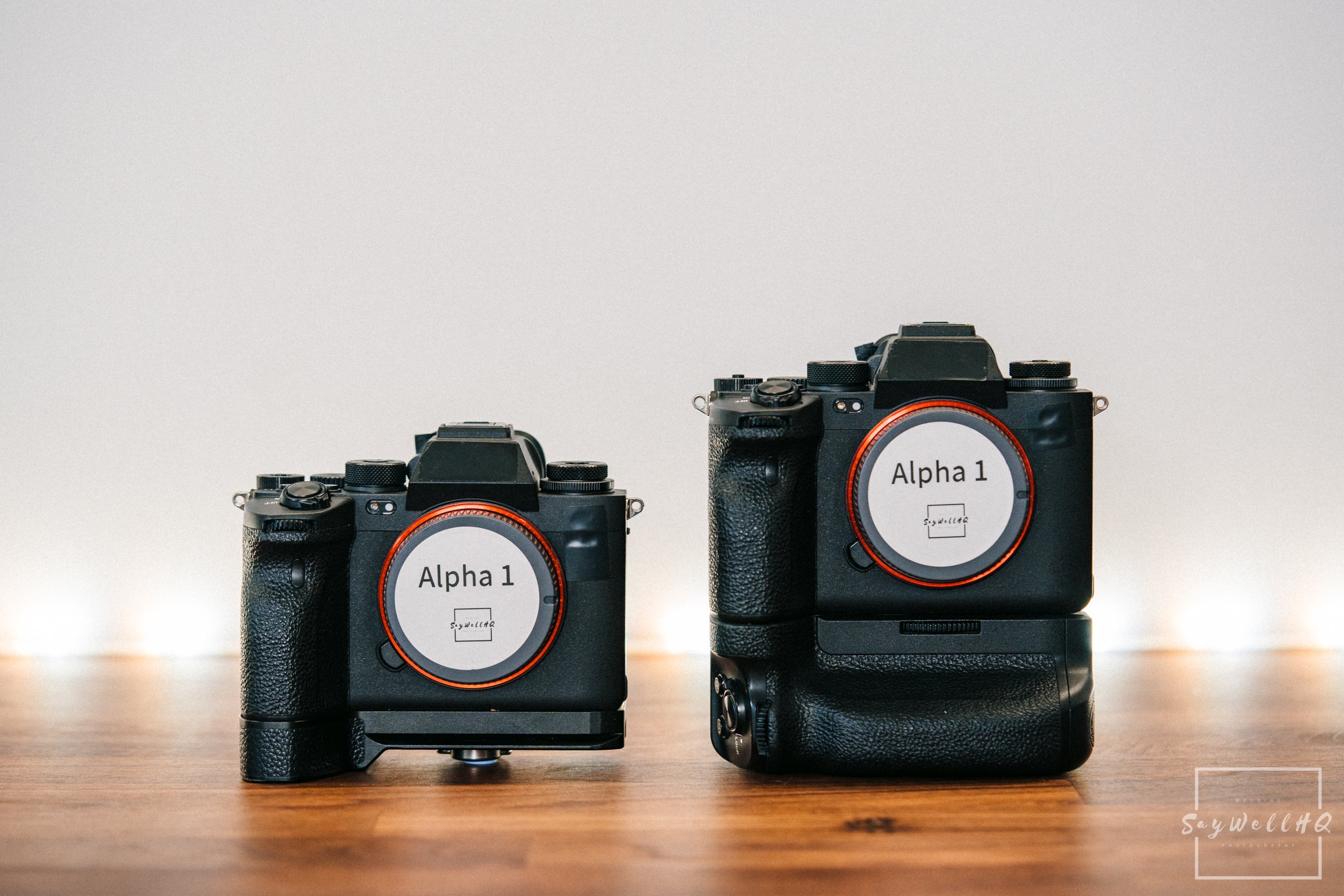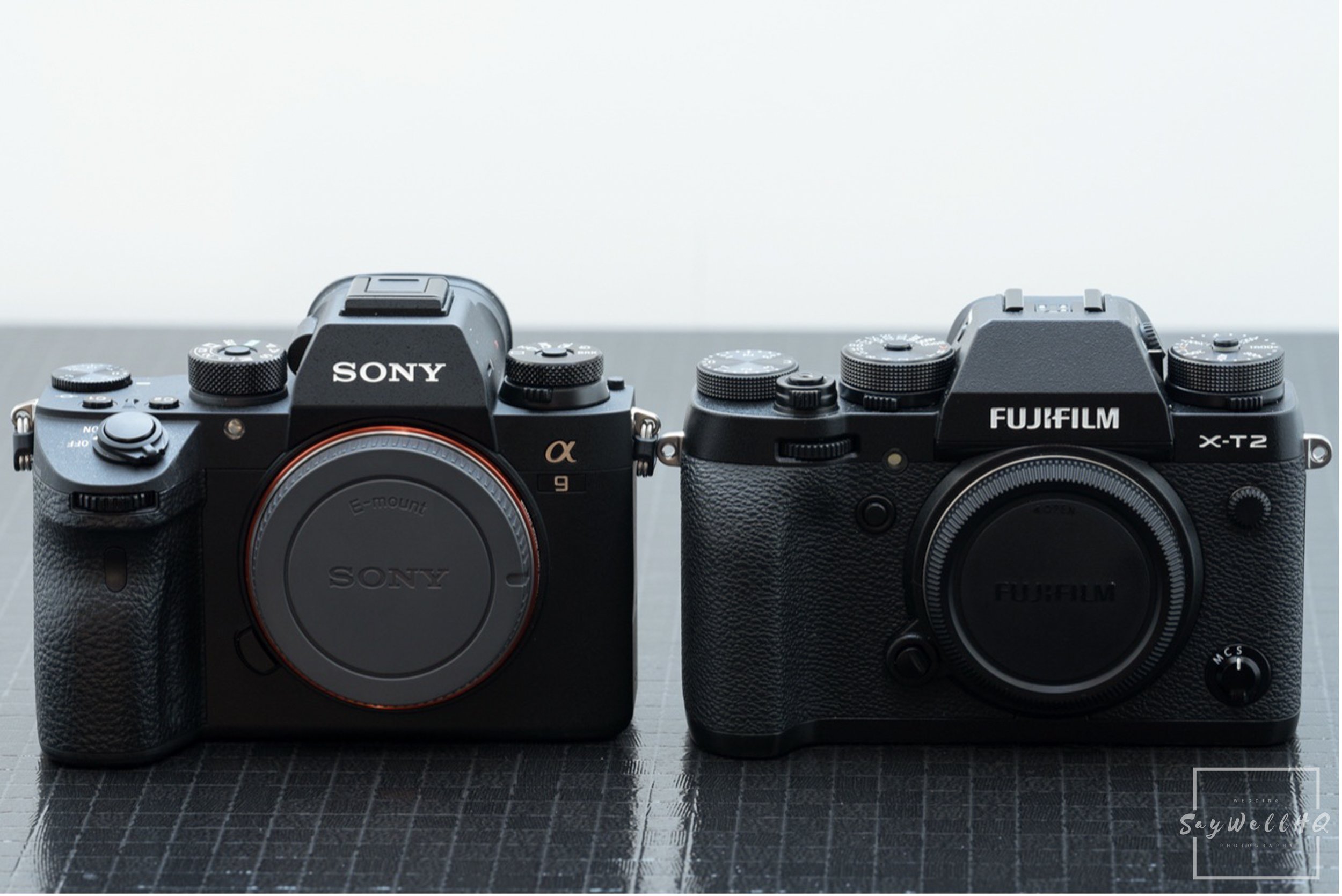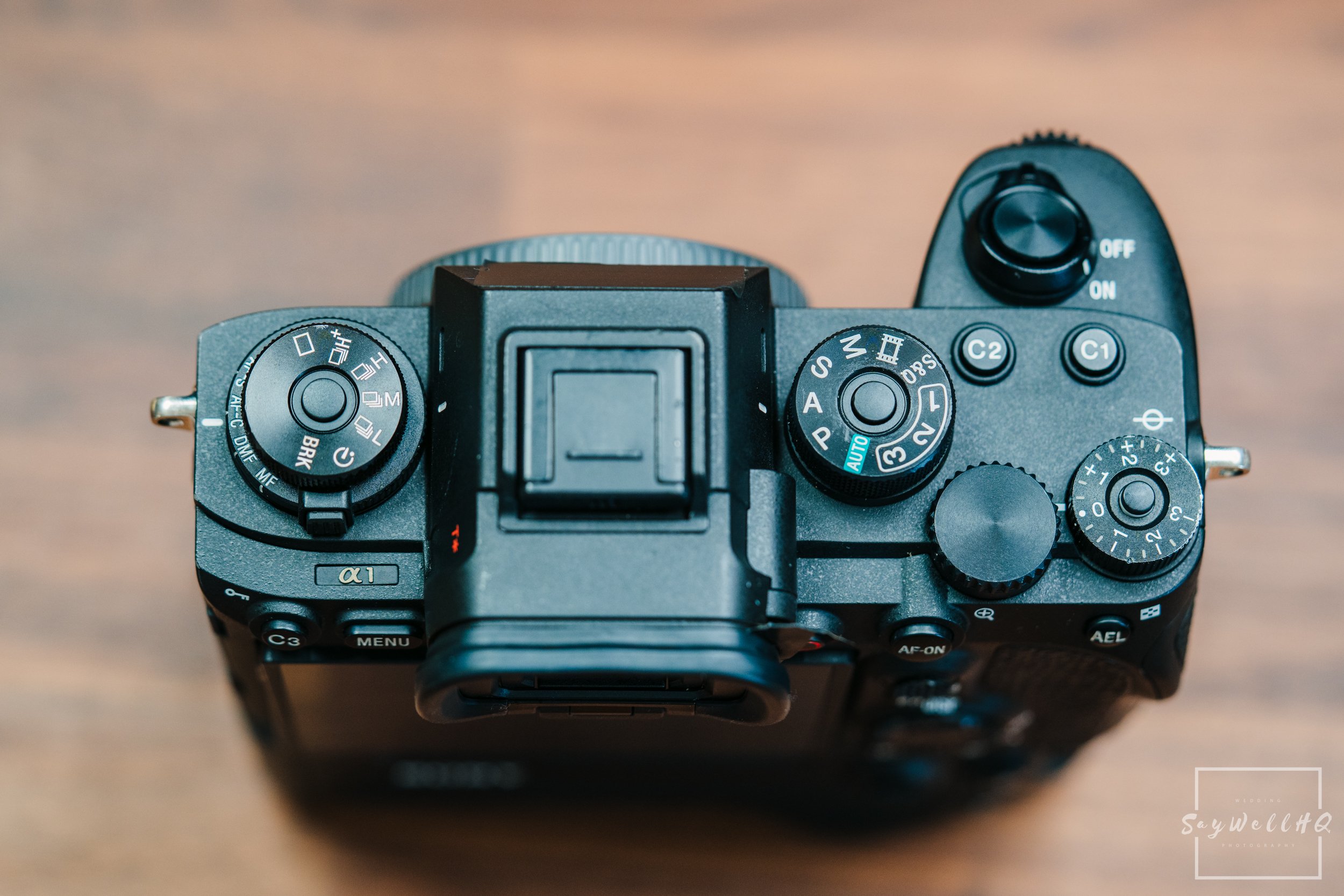REVIEWS | SONY A1 FOR WEDDING PHOTOGRAPHY - REAL WORLD REVIEW
In this blog post I discuss and review the Sony A1 after 200+ weddings
MY SONY CAMERA & LENS SET-UP FOR WEDDINGS
In my other post about the Sony cameras and lenses I use at weddings, I discuss how I use three cameras at every wedding, but it's worth mentioning it here again as it will make more sense when you read through this post.
Typically, for 90% of a wedding day, my camera and lens combo looks like this:
Sony Alpha 1 + Sony FE 35mm F1.4 GM Lens (camera on my Holdfast strap)
Sony Alpha 1 + Sony FE 50mm F1.2 GM Lens (camera on my Holdfast strap)
Sony Alpha A9ii + Sony FE 20mm F1.8 G Lens (camera in my hip bag)
Typically, for the remaining 10% of a wedding day (from 7 pm onwards) my camera and lens combo often looks like this:
Sony Alpha 1 + Sony FE 24mm F1.4 GM Lens (camera on my Holdfast strap)
Sony Alpha 1 + Sony FE 50mm F1.2 GM Lens (camera on my Holdfast strap)
Sony Alpha A9ii + Sony FE 24mm F2.8 G Lens (camera with flash for the dancefloor)
UPDATE JULY 2023 - The Sony A9ii has now been sold and replaced by a third Sony A1.
UPDATE APRIL 2025 - I have now bought the Sony FE 28-70mm F2 GM - Blog coming in the summer after 15-20 weddings.
MY HISTORY WITH SONY
For two years, in 2016 and 2017, I shot with Fujifilm cameras. I started out with an X-T1 and an X-T10, but after a few weddings I realised I couldn’t cope with using two different camera bodies, so I switched to shooting with a pair of X-T1s.
I stuck with Fuji until the end of 2017, when one particularly bad experience at a wedding made me decide it was time to explore other options.
Step forward Sony.
My plan was to dip my toe into the Sony E-mount system and run it alongside my Fujis. I picked up a Sony A7R III and the Sony FE 85mm f/1.8 from Wex, with the idea that this combo would replace one of my X-T2s and the sluggish-to-focus 56mm f/1.2.
Within five minutes of testing the A7R III with the 85mm, I knew I was in financial trouble. The responsiveness, the speed and accuracy of the autofocus, the immediate trust I had in the camera — and the realisation of just how inconsistent the Fujis had been — made it clear my future lay with Sony.
In February 2018, I was travelling halfway across the country to Wex, armed with my Fuji X system bodies and lenses, plus my GFX kit. I traded the lot for two Sony A9s and a healthy dose of Sony glass.
I’ll never forget my first wedding with Sony — it was night and day compared to my last with Fuji. With Fuji, I always felt the cameras and lenses were the weak point in my setup. I could see moments unfolding, but the gear wasn’t quick or accurate enough to catch them. With the A9s, the weak point was me.
The A9s stayed with me until October 2019, when Sony released the A9 II. It fixed the niggles: better handling, a larger AF-ON button, two UHS-II card slots (instead of the frustrating mix of UHS-I and UHS-II), a much-improved mechanical shutter — faster, more responsive, and better damped — plus anti-flicker mode in mechanical shutter.
In my view, the A9 II was the perfect wedding camera: 24MP, superb image quality, class-leading autofocus, an electronic shutter you could use all day at weddings, excellent low-light performance, rock-solid reliability, and a bulletproof build. I genuinely couldn’t think of anything else I wanted from a camera.
And then, on the 27th of January 2021, everything changed.
THE CAMERA NO-ONE EXPECTED
With the world still in some form of lockdown, January 27th 2021 brought a jolt of excitement — Sony announced its most advanced mirrorless camera yet: the Sony Alpha 1. I remember sitting and watching the YouTube launch, the specs flashing up one after another, each one more jaw-dropping than the last. The speed alone looked unreal. A few of the headline features that stuck with me were:
Brand new 50.1MP full-frame sensor
30fps continuous shooting with full AF/AE tracking in full-resolution RAW
Improved Eye AF for humans and pets
Silent electronic shutter with new anti-flicker technology
Five-axis in-body image stabilisation
Electronic shutter flash sync at 1/200 – a first for a full-frame mirrorless camera
New mechanical shutter with 1/400 flash sync – also a first for full-frame mirrorless
Shutter life rated at 500,000 actuations
9.44-million-dot OLED viewfinder with a blistering 240Hz refresh rate
S-Cinetone video and updated colour science
What Sony had essentially done with the Alpha 1 was merge the best of all their flagship lines — the speed of the A9 series, the video capabilities of the ‘S’ series, and the resolution of the ‘R’ series. No more choosing between speed, resolution, or video — this was all three, in one camera.
DO YOU NEED A 50 MEGAPIXEL CAMERA?
No, no you don't.
But I already knew exactly what I wanted to do with the Sony A1 and its 50MP sensor — let me explain.
For most of my career, I’ve been a 35mm and 85mm wedding photographer. The 35mm is my go-to documentary lens, while the 85mm is what I’d reach for when I needed a bit more reach.
The thing is, I’ve never truly loved the 85mm focal length. It’s always felt a bit too long, too tight — and I’m very much a close-proximity wedding photographer.
The A1 changed that. With its 50MP sensor, I could shoot with my 35mm in full, glorious resolution, and with a single press of a custom button, instantly switch to APS-C mode — turning my 35mm into the reach of a 50mm. Even in APS-C mode, I’d still get a 21MP RAW file, giving me plenty of flexibility to crop and recompose in post.
The same magic applied to a 50mm lens: full 50MP detail in standard mode, and with APS-C engaged, a 75mm reach without swapping lenses. That kind of versatility was a game changer for the way I work.
DO YOU NEED A CAMERA THAT SHOOTS 30FPS?
No, no you don't.
At weddings, I regularly shoot at 10 or 15fps — usually for moments like the walk down the aisle, the first kiss, the confetti throw, or when guests are playing games.
I’ve only ever used 30fps by accident, when I’d knocked the dial into H+ mode. Because I shoot in silent mode all day, you don’t hear it — the only giveaway is watching your frame counter drop much faster than expected.
For wedding photography, 30fps is complete overkill. But for sports shooters or wildlife photographers capturing birds in flight, that kind of speed can make all the difference.
SILENT SHOOTING WITH THE SONY A1
Since moving to Sony in late 2017/early 2018 with the A9, I’ve always photographed weddings in electronic shutter mode whenever possible. It completely changed how I work. Not having the constant click of a shutter during a quiet ceremony, or in the middle of an emotional father-of-the-bride speech, is something I’ll never want to give up.
The A9 handled most situations brilliantly in silent mode, but certain venue lighting could cause light banding, forcing me to switch to the mechanical shutter. The A9 II, with the same sensor and read-out speed, was much the same — excellent most of the time, but not perfect.
The A1, however, is flawless. In over 200 weddings, I haven’t once had to revert to mechanical shutter because of flickering or banding. Its ultra-fast sensor read-out, combined with anti-flicker technology in electronic shutter mode and the variable shutter function, means I can shoot silently in any lighting condition.
I’ll never own a camera that can’t shoot an entire wedding day in electronic shutter. Once you’ve experienced the silence — and seen how people relax and let you get closer — you’ll never want to go back to mechanical.
THE MECHANICAL SHUTTER ON THE A1 vs A9ii vs A7IV
Although I only ever use the Sony A1 in electronic shutter mode for weddings, I know there are photographers who still prefer mechanical.
The A1’s mechanical shutter is new for the Alpha 1 and is as refined as it gets on a full-frame mirrorless camera. It offers a 1/400s flash sync speed, an uprated lifespan of 500,000 actuations, and a damped vibration system that makes it sound like a silenced pistol.
For fun, I recorded the shutter sounds of a few of my cameras so you can hear the difference. All were recorded on a Sony TX650 held at the lens mount, using the 90mm macro at f/2.8 and 1/250s.
The A1 is beautifully damped — the A9 II comes in second, still good but noticeably louder — and then there’s the A7 IV, which, to my ears, is far too loud and has all the charm of scaffolding collapsing.
THE SONY A1 MENU SYSTEM
Sony has always taken some heat for its menu system — the original layout on the A9 was widely seen as confusing and poorly organised.
The A1 arrived with Sony’s newer menu system, first introduced on the A7S III. It’s far better organised, with clearer names and more logical groupings of settings.
In Sony’s defence, once you’ve set up your My Menu and customised the FN button menu, you rarely need to dive into the full menu at all. Yes, there are a lot of options — but the A1 is a complex camera, and Sony deserves credit for allowing you to tweak almost every setting and customise every button to suit your shooting style.
One of my favourite newer features on Sony bodies is the ability to back up your settings to an SD card. Originally designed for AP Newswire photographers — who could walk into an assignment, pop in their SD card, and instantly load their preferred setup — it’s incredibly useful for wedding photographers too. I keep a backup of my A1 settings so that if I ever need to borrow or buy another body, I can have it ready to go in seconds. It’s also perfect for syncing two cameras, ensuring they both share identical settings and button layouts.
MY SONY A1 SETUP
In the following gallery are photos of the ‘my menu’ settings, the ‘fn’ menu button options and finally, the customisation settings for each of the buttons on the camera.
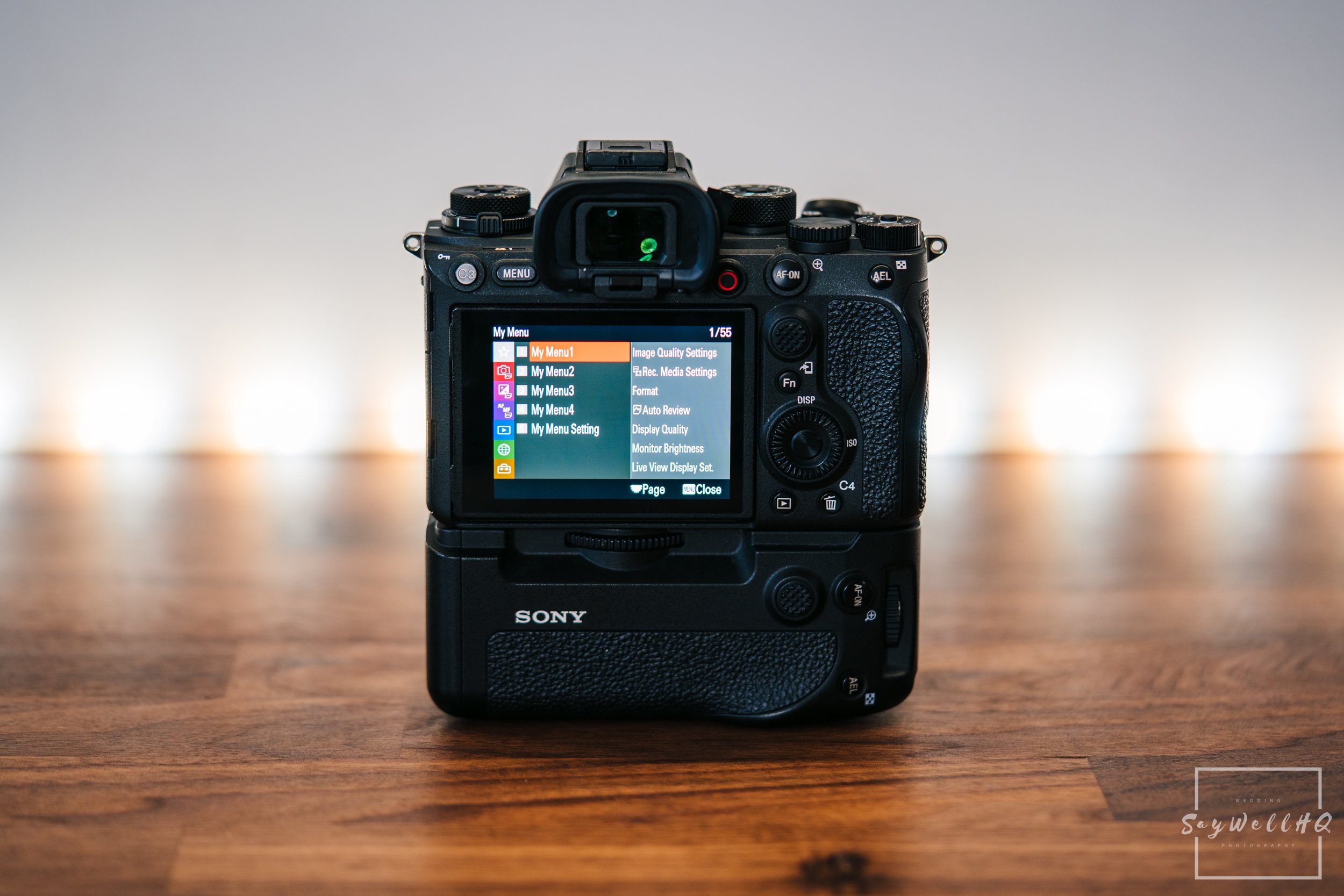
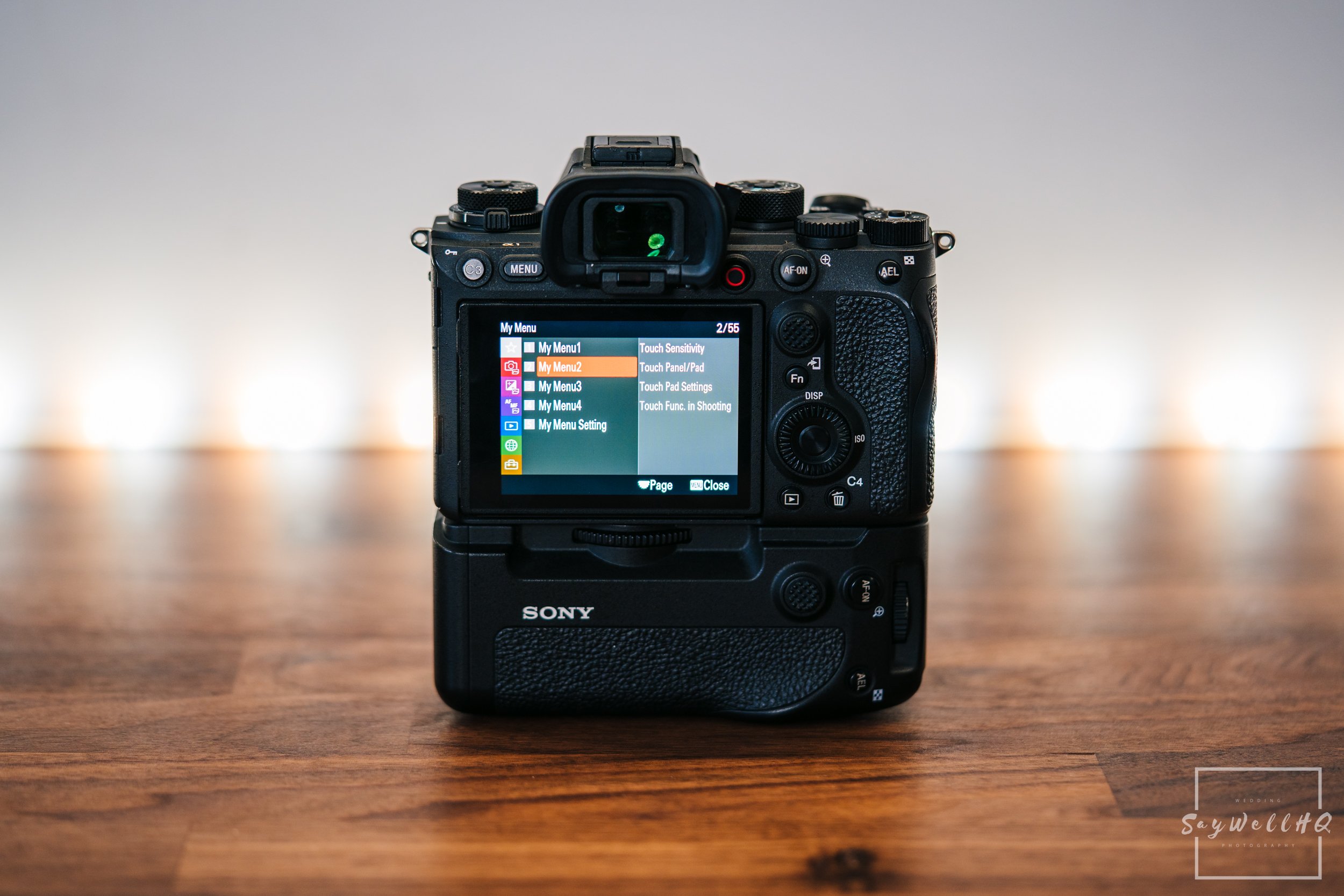
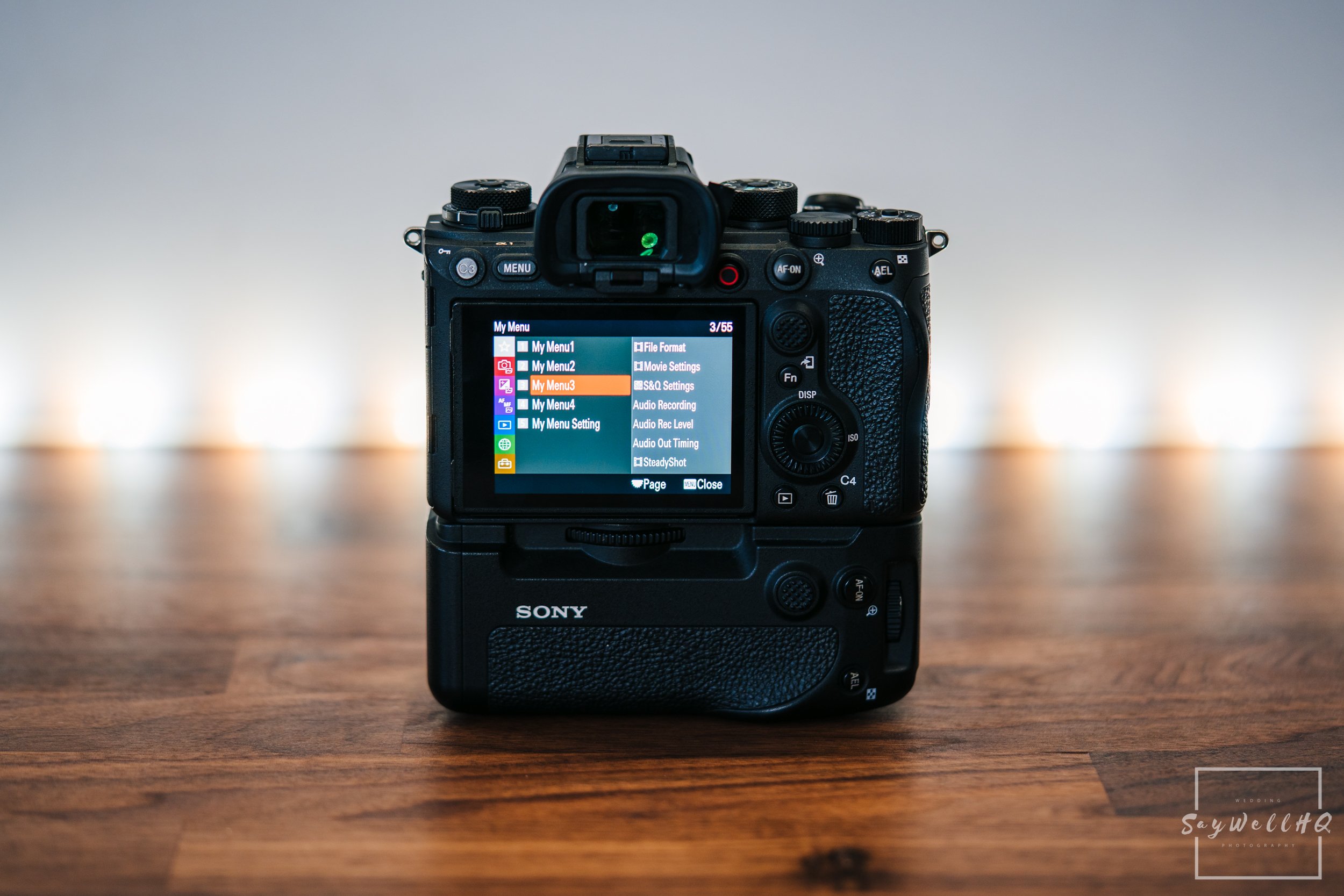
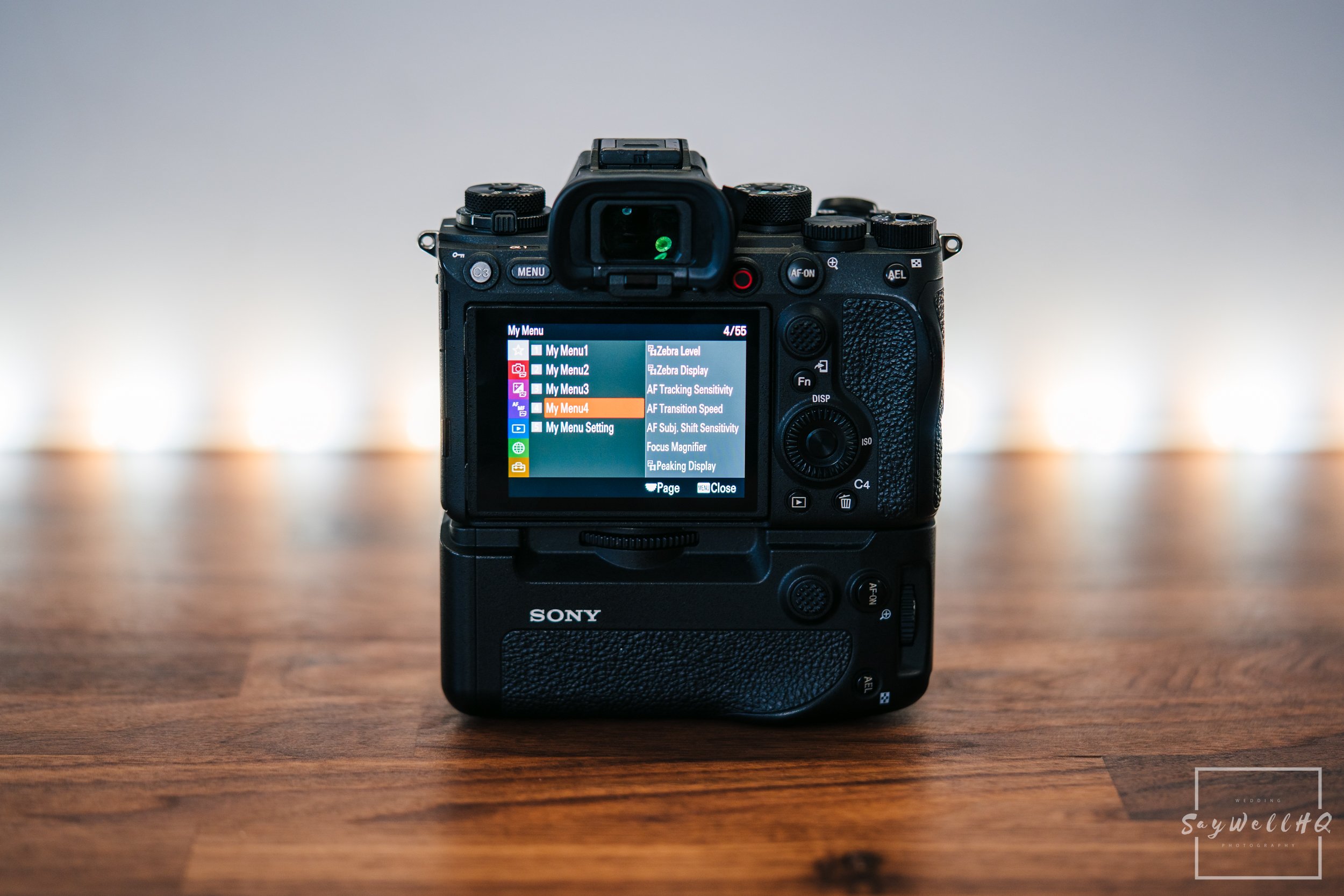
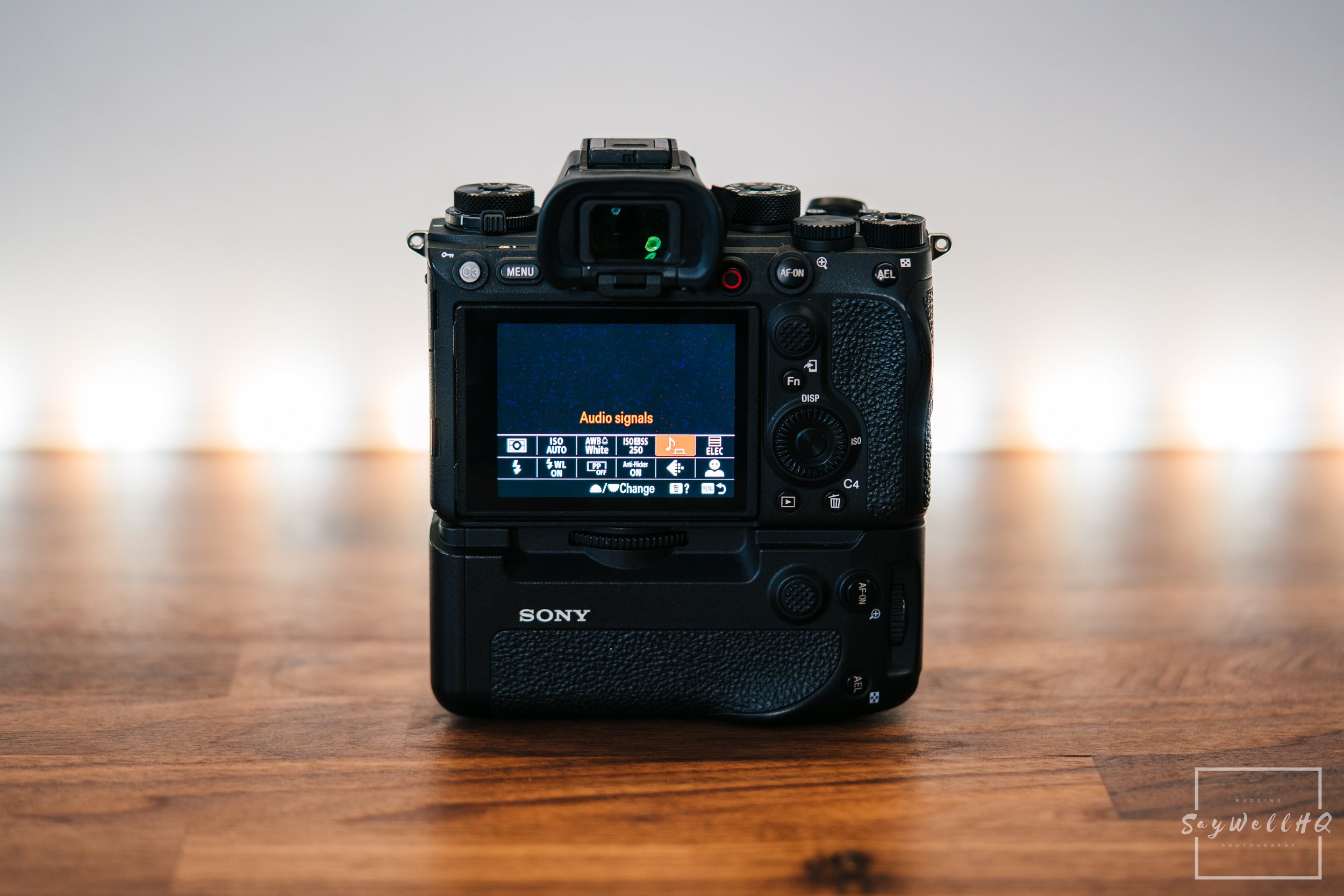
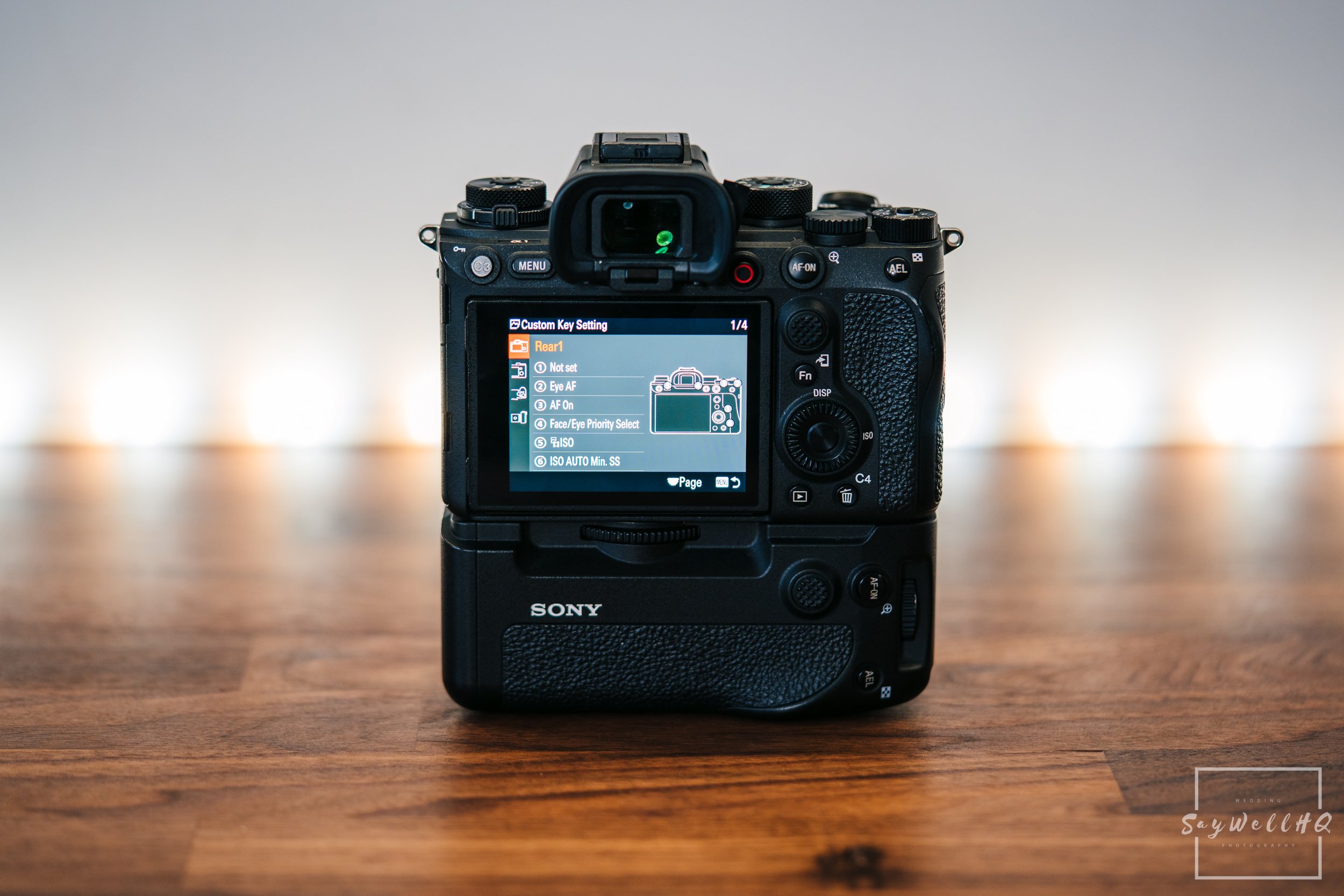
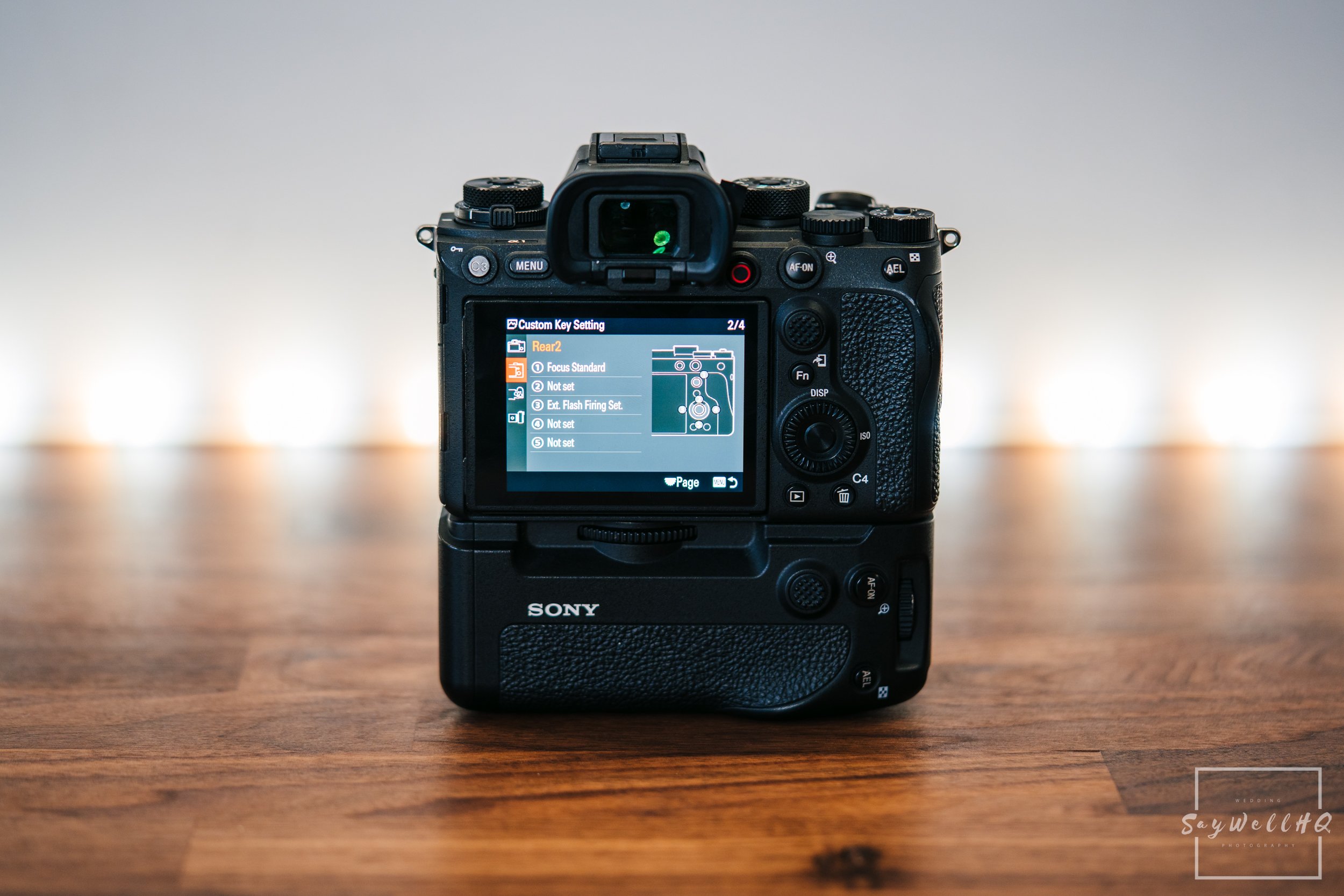
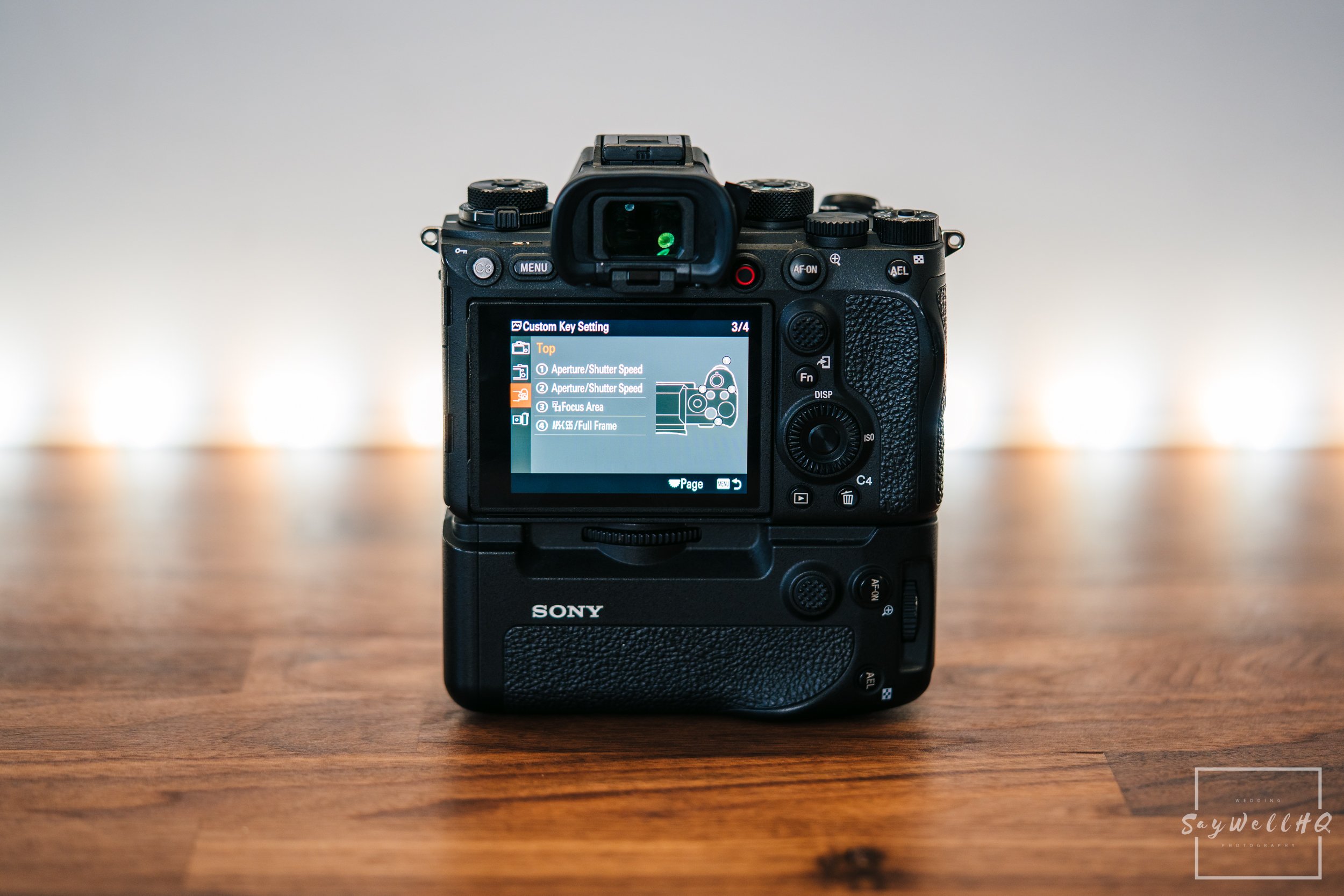
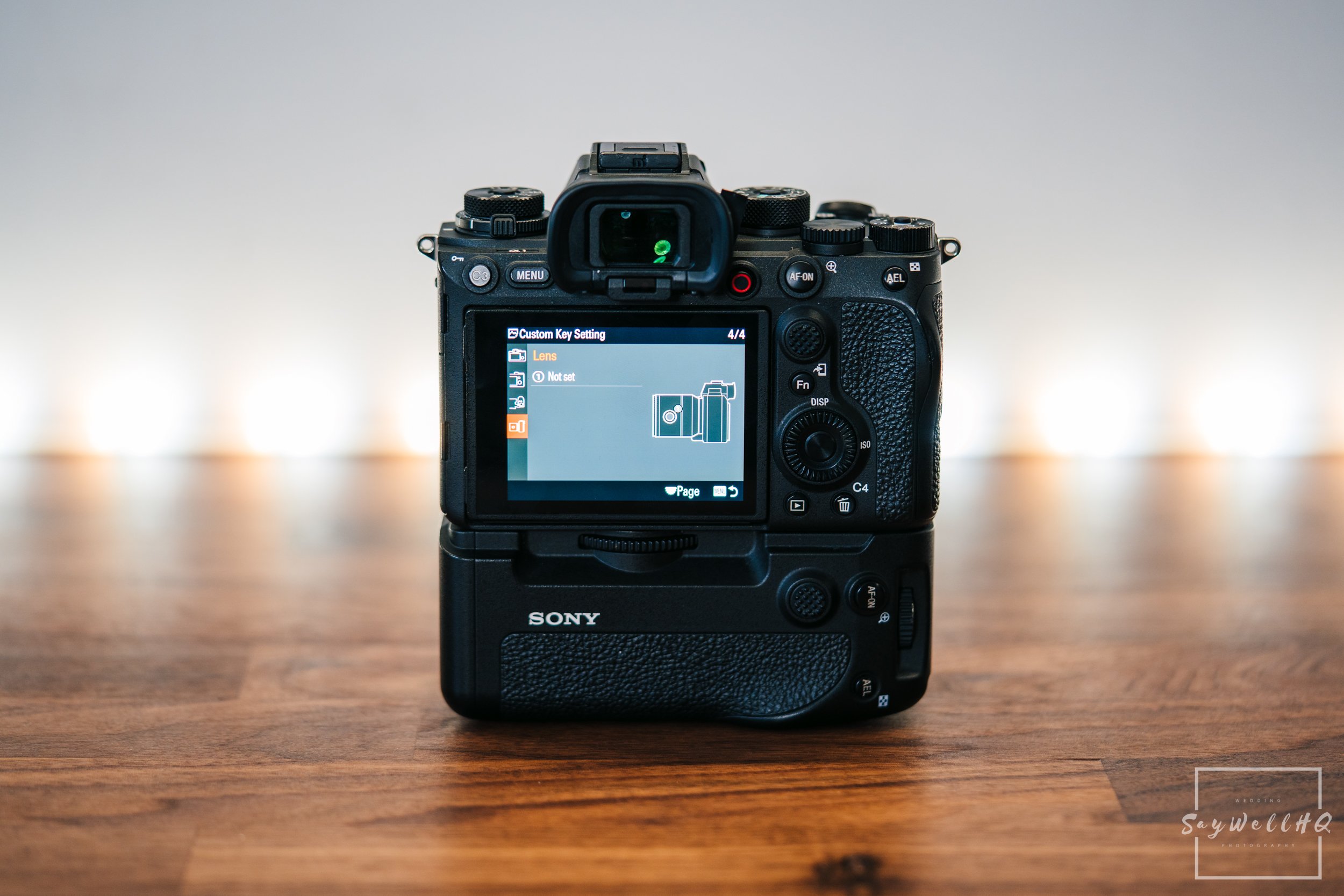
SONY A1 FIRMWARE
Firmware updates are always a hot topic in Facebook groups and forums, no matter the camera brand. Some photographers believe a flagship camera should always get the latest features found in newer — and sometimes cheaper — models. I understand that view, but for me, as someone who relies on my cameras to make a living, firmware has one job: work flawlessly, be reliable, and cause zero issues.
The reality is, very few camera manufacturers release firmware updates without problems. Almost every time a new update drops, the camera-buying public discovers bugs, and soon after, a “fix” update follows. (Canon, Sony, Fujifilm — yes, I’m looking at you.)
All three of my Sony A1s are still running firmware v1.31, released back in September 2022. Sony rolled out a major update (v2) in June 2024, only to pull it and replace it with v2.02. I have no plans to install it. My cameras perform perfectly — they only miss when I miss — and they’ve never skipped a beat, so I see no reason to mess with that.
When my A1s went in for a full service a few weeks ago (January 2024), I even told them: “Do NOT update the firmware!”
Update – April 2024: Still on v1.31. Still no intention of changing that.
HOW I DELIVER AND STORE MY A1 RAW FILES
As a wedding photographer and a wedding photographer who takes a lot of images at a wedding, I can easily come back with 10k images across my A1’s, and this could mean I have in the region of 300-500GB of data to be stored before I start the cull and the final edit..
My process woks like this:
Back-up the SD cards from Slot number 1 to a portable SSD drive.
Back-up the SD cards from slot number 2 to a RAID Drive in my studio.
First cull the images on the portable SSD drive (10k to 3k of images).
Cull the first cull down to around 2k images which I take into LR.
Quick cull in LR to make sure I’m happy with the images to be edited.
Edit the images in LR.
Export the edited images but do so at 6000 x 4000 pixels (this works out to be 24 megapixel files)
Upload the Images to Pictime.
RAWSIE all the RAW Files which did not make the Final Cut.
RAWSIE the LR Catalogue for the wedding.
Copy the RAWSIE’d LR Catalogue and final files to my NAS drive.
Import the RAWSIE’d LR Catalogue into my master wedding LR archive.
ZIP the RAWS which I used to deliver the JPG’s and place in the cloud.
Format the SSD and Raid drive of the wedding.
Looking through the above list, there are three things that I want to talk about. 1 - RAWSIE, 2 - Export settings, 3 - NAS Drive.
RAWSIE
I have used RAWSIE (or Dot Photon) for around five years, it's a program that can compress a RAW file image size by upto 5:1. In real terms, it can take a Sony A1 RAW File saved on the computer with a saved size of 56mb down to 18mb without any loss to resolution size, bit count change, colour loss and does not cause any lossy artefacts.
For a 500 photo wedding delivery, my saved size on the computer without RAWSIE would be 280gb of data vs RAWSIE file size of 90gb of data - that’s a big difference.
RAWSIE has saved me a small fortune on not having to buy storage, the ability to save nearly 70% of the saved down file size, makes life so much easier, and for me, RAWISE is a must for anyone who uses the Sony A1 and generates a lot of RAW FILES.
Update July 2023 - RAWSIE has recently announced that they will stop the support for their RAWSIE application and will incorporate their technology into a new app, no date is set for the new app, but support for me will run until the end of this year when my licence runs out.
Update August 2025 - RAWSIE is still running and running well on my MAC’s, but obviously support for cameras released after July 2023 will not be able to be compressed, but I’m still using it on my Sony A1’s.
EXPORT SETTINGS FOR WEDDINGS
My couples don’t need 50.1-megapixel JPEGs for their wedding photos (that’s 8640×5760 pixels) — the full-resolution files are for me.
I export my Sony Alpha 1 wedding JPEGs at 6000×4000 pixels, which works out to 24 megapixels — the same size I used to export from my Sony A9 II files (my third camera body at the time).
For me, 24MP is the sweet spot for wedding images. It’s perfect for everything from small prints to large wall art, and when saved as JPEGs, the files are typically 6–10MB — a nice, manageable size for downloading and sharing.
Update – July 2023: Even after selling my A9 II and replacing it with a third A1, I still export at 24MP. It’s the ideal balance between resolution, storage, and client downloads.
Update – August 2025: I’m still delivering files at 6000×4000 pixels (24MP), but I now offer couples the option to pay a little extra for the full 50.1MP JPEGs. That said, 24MP remains more than enough for beautiful, high-quality wedding photos.
THE NAS DRIVE
All my delivered RAW and JPEG files from every wedding I’ve ever photographed are stored on my Synology NAS drive.
The NAS is a crucial part of my workflow for handling Sony A1 files — it’s expandable, accessible from anywhere in the world, and has built-in redundancy for peace of mind.
Every A1 RAW file on my NAS has already been compressed using RAWSIE to maximise storage efficiency without sacrificing quality.
Update – August 2025: Still using — and loving — my NAS setup. I currently run a Synology DS1520+ with 30TB of storage, holding over 250 weddings (delivered JPEGs, matching RAWs, blog images, slideshows, and more). Being able to quickly access anything from any wedding, anywhere in the world, is a game changer for my workflow.
IS THE SONY A1 THE PERFECT WEDDING CAMERA?
The Sony A1 is, in my view, the perfect wedding camera — for both photographers and videographers. It has everything you could possibly need in one body.
As I mentioned in the intro, Sony designed the Alpha 1 to merge the best of all three of its flagship lines: the speed of the A9 series, the resolution of the ‘R’ series, and the video capabilities of the ‘S’ series. The result is a camera that truly can do it all — and do it brilliantly.
What makes the Sony Alpha 1 the best camera for weddings — not just the best Sony camera, but better than the Nikon Z9, Canon R3, or Canon R5 — is its absolute reliability. It will work in any scenario, delivering outstanding photos and video without compromise.
There have been weddings where I know my old A9 II, had it been my main camera, would have struggled — in low light, in mixed lighting, or in extreme backlight. The A1 is the one camera I can take to any wedding with 100% confidence it won’t let me down. Whatever the situation, it just works.
Search YouTube or Google for “best Sony camera for weddings” and you’ll probably see the A7 IV or the A7R V mentioned. But neither of those can hold a candle to what the A1 can do. Nine times out of ten, the reason reviewers recommend them is price — they’re far cheaper than the A1. And there’s a reason for that: they’re not as good.
Some argue that the A7R V’s dedicated ‘AI’ processor makes its autofocus better than the Alpha 1’s. Having tried the A7R V at a Sony hands-on event, I can say with complete confidence that the A1’s autofocus is faster to acquire, more accurate, and delivers a higher hit rate of in-focus shots.
The A1 doesn’t have a flashy ‘AI’ processor — it doesn’t need one. It can capture 30 full-resolution 50.1MP images per second with blackout-free EVF shooting, tracking a subject’s face or eye while adjusting shutter speed, ISO, and white balance — all while writing to two SD cards and the buffer. You can still access every menu option while files are being written, with an incredible in-focus hit rate. No other camera from any brand can match that.
And it can do all of this silently in electronic shutter mode, with anti-flicker settings running in the background.
The Sony Alpha 1 is, without doubt, the best wedding camera available for photographers and videographers. But it comes at a price — £6,500 RRP here in the UK.
If you want Sony’s best, it’s the A1. If the price is too steep, or its feature set goes beyond what you need, Sony’s other offerings — like the A7 IV or the A7R V — might suit you better. But if you want the ultimate tool for the job, the Alpha 1 is it.
Update – November 2024: On the 19th of November, Sony announced the Sony A1 II. Everything I’ve written above still holds true — both for the original A1 and now for the A1 II.
UNBOXING A NEW SONY A1 CAMERA
WHAT I WANT FROM THE SONY A1ii & WHEN WILL IT COME?
Although I’ve said throughout this article that the Sony A1 is the best camera for weddings, there are still a few things Sony could improve for the next version:
LCD Screen
The rear LCD needs an upgrade. It should still tilt up as it does now, but also flip out to the side for easier self-filming — just like the A7R V. The screen itself needs higher resolution, no visible “dot” pattern, and none of the blooming issues we see on the A7R V’s display.
Locking Dials
The main dials need a consistent locking system. At the moment:
The FPS/speed dial (left of the EVF) requires holding down a central button while turning.
The PASM dial (right of the EVF) works the same way.
The exposure compensation dial (back right) uses a press-to-lock mechanism.
I’d love to see all three use the same press-to-lock design as the exposure compensation dial. It’s faster, easier, and far more intuitive than holding down a button while turning.
MAKE IT EASIER TO SWITCH FROM PHOTOS TO VIDEO
I don’t shoot much video, but when I do, it’s often mixed in with stills — and switching between the two on the A1 isn’t as quick as it should be.
Right now, you have to press and hold the button on the PASM dial, then rotate from your chosen photo mode to video mode. It’s not exactly a fast process.
I’d love to see the A1 II adopt the PASM dial design from the A7 IV, where the photo/video mode switch is built into the front of the dial. That way, it’s just a quick flick to move between stills and video — no button pressing required.
LIGHTUP BUTTONS / DIALS
Keeping with the theme of dials and buttons, I’d love to see Sony implement something similar to the Nikon Z9 — illuminated controls.
On the Z9, the on/off switch has an extra click beyond “on” that lights up the dials and/or buttons. You turn the camera on as normal, then push the switch one step further to keep the camera active while illuminating the controls. Release it, and it drops back to the standard “on” position.
Having backlit buttons and dials on the A1 II would be incredibly useful in low-light conditions. For example, as you can see from the top view of the camera above, the “speed/FPS” dial has seven different settings. If you’re trying to change from ‘M’ to ‘L’ and then on to ‘H’ in the dark, it’s guesswork unless you shine a torch on it. Built-in illumination would make those adjustments quick, accurate, and effortless.
‘AI’ SUBJECT DETECTION
We all know “AI” is the buzzword of the moment, and Sony has already brought it to the A7R V, allowing the camera to track a range of subjects — from people to cars, planes, and even insects. But you still have to tell the camera what to track, and then it simply uses algorithms to follow that chosen subject. To me, that’s not true AI — it’s just subject tracking based on your input.
What I want to see in the next A1 is a camera that can recognise what I’m photographing without me telling it. It should know the parameters of the subject and track it automatically.
On the A7R V, if you want to follow a person, you first have to select “human.” If you then want to track a car, you need to change the setting. Then, if a dog runs into frame, you have to switch again. In fast-moving situations — say a person, then a car, then a dog — by the time you’ve told the camera what to follow, the moment is gone.
The next A1 needs AI that instantly identifies and locks onto whatever is in front of you, switching seamlessly between subjects without manual input. That would be true AI.
THE DIOPTER DIAL
You’ll notice in some of the A1 images below that I’ve taped over the diopter dial. That’s because I’m forever catching it by accident, which means the next time I look through the EVF, everything is blurred and I have to readjust it to get a clear view.
This needs fixing. Either the diopter adjustment should be lockable, or Sony should move it to a menu setting that electronically adjusts the diopter inside the camera. That way, it can’t be knocked out of place during a wedding shoot.
FULL FRAME & APSC - MAYBE MORE?
With the Sony A1’s sensor delivering 50.1MP in full resolution and 21MP in APS-C/crop mode, I’d love to see Sony add more crop options.
Currently, APS-C mode is a 1.5× crop — so a 50mm lens becomes a 75mm equivalent while still producing a 21MP file. But imagine if we could also choose a 1.75× or even a 2× crop, assignable to a custom button.
That would let you jump instantly from 50.1MP full-frame, to APS-C, and then to an extra crop mode — all without changing lenses. For example, the Sony 50mm f/1.2 GM could effectively give you 50mm, 75mm, and around 90mm (at maybe 10–12MP) at the tap of a button. That kind of flexibility would be a game-changer for wedding work.
IN CAMERA RAW EDITING
I’d love to see Sony add some form of RAW photo editor directly into their cameras, giving us the option to make quick edits on the go. Fujifilm has offered this for as long as I can remember — partly thanks to their film heritage, which inspired their in-camera film simulations to replicate classic film stocks.
Yes, Sony doesn’t have that same stills film history, but it would still be incredibly useful to have in-camera editing options. Even better would be the ability to use Sony’s own colour profiles or upload custom LUTs — much like my Lightroom presets — straight into the camera. It wouldn’t replace a full editing workflow, but for quick turnarounds or same-day previews, it would be a fantastic addition.
WHEN WILL SONY RELEASE THE NEXT A1 the A1ii?
The Sony A1 is a true powerhouse, and it’s going to take something special to release a newer version that can do things the original A1 cannot.
In my view, the next A1 will likely arrive in late 2024 or early 2025. Before that, Sony needs to update the A9 series (with an A9 III) and the ‘S’ series — then combine the best of both into the new A1.
My guess? We’ll see an A9 III in 2024, followed by the A1 II either at the very end of 2024 or the start of 2025.
SONY ANNOUNCES THE SONY A1II
On the 19th of November 2024, Sony announced the Sony A1 II, and it appears to have fixed some of the issues I’ve mentioned in this post. I haven’t had hands-on time with the camera yet, but from the information released so far, Sony has addressed several of my concerns and added a few extra functions. Here are a few that caught my eye:
Refined body design: Borrowing from the A9 III, the A1 II features a deeper, more comfortable grip—spaced further from the lens mount for better handling, especially with large lenses.
Updated button layout: Includes a new customizable front C5 button and refined shutter placement for natural operation.
Display Enhancements
4-axis vari-angle LCD screen: A fully articulated 3.2″ touchscreen (2.1 million dots) that flips, tilts, and rotates—perfect for video and difficult angles.
Improved EVF: Still 9.44 million dots OLED, but now offers smoother viewing with a new 120 Hz full-resolution mode in addition to 240 Hz, plus a more comfortable eyecup.
Autofocus & AI Processing
Dedicated AI chip: Enables enhanced subject recognition including auto subject detection (birds, vehicles, humans, etc.) and improved pose & eye tracking.
Performance boost: Sony claims around 30% better eye detection for humans/animals and 50% better bird eye detection.
New Shooting Modes
Pre-capture buffer: Captures up to 1 second of RAW frames before the shutter is fully pressed, giving you a safety net for split-second moments.
Speed Boost button: A customisable front button lets you toggle burst modes (e.g., from 15fps to 30fps) instantly—no menu diving required.
Image Stabilisation
Upgraded IBIS: Now rated up to 8.5 stops of stabilisation in the center (and 7 at edges), a big leap over the original A1’s ~5.5 stops.
Video Features
LUT support & Auto Framing: Offers LUT import for monitoring and auto-framing tools—handy for video creators.
Cinematic controls: New shutter speeds (1/48, 1/96) make it easier to maintain proper motion blur, plus focus mapping and auto still extraction from video.
The A1 II isn’t a complete overhaul—but these thoughtful upgrades, especially in autofocus, ergonomics, stabilisation, and workflow, make it a meaningful evolution of an already legendary camera (in my eyes!).
With Sony’s upgrade cycle, the pattern is clear: the Mark I models (like the Sony A9 and Sony A1) set a new benchmark, introducing technology that’s fresh to the industry. The Mark II models (A9 II, A1 II) are refinements — fixing issues, improving ergonomics, and adding a few new features. The Mark III releases are where we typically see the next big leap, as with the jump from the A9 II to the A9 III, which was almost an entirely new camera.
The Sony A1 II is a great update, but for me, it’s not worth the upgrade. I’m more than happy with what the original A1 has brought to my wedding work. If I were to damage one of my current A1 bodies, I’d simply replace it with another A1 rather than an A1 II — the extra cost just isn’t justified for what I need in a camera.
Update – August 2025: I finally had the chance to get hands-on with the A1 II at a local Sony event. The handling is noticeably improved thanks to the deeper grip, and the new switch for moving between photos and video is exactly what the original A1 needed. The LCD is pretty much perfect — solid, clear, and a big step up.
Shooting was limited to a single model, so I couldn’t fully push the camera, but the autofocus felt very similar in speed to the A1. I suspect it will show a real jump in performance at an actual wedding, although the original A1 was already pretty much faultless in that department.
I still stand by my November 2024 comment: it’s a nice upgrade, but the A1 is all I need right now. If I had to replace one, I’d buy another original A1 again in a heartbeat.
